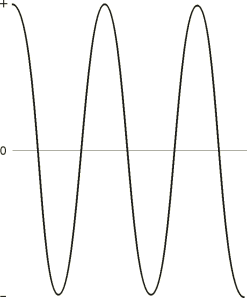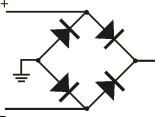Op-Amp Power Supply Quality Considerations
Introduction
Op-amps use a DC supply voltage, typically anywhere from a few volts on up to 30 V or more. If the power supply is a perfect DC voltage source (that is, it gives the same voltage no matter what happens), the op-amp’s output would be solely governed by its inputs. Since there are no ideal voltage sources in the real world, you have to worry about the power supply’s quality if you want the best performance from an op-amp. This article will describe the faults of common power systems with a focus on how they affect op-amp audio applications.
Batteries
Batteries are close to ideal voltage sources, provided that you stay within their design limits.
First, some terminology. Cells are the ∼1.5 V or ∼1.2 V units that make up a battery; a battery is multiple cells in series. It’s incorrect to call an AA cell a battery. When I use the term “battery” below, I am either referring to a self-contained unit like a 9 V battery (composed of 6-8 cells, depending on the type), or several AA or AAA type cells in series.
The primary parameter to be concerned about is the impedance of the cells you will be using. An ideal voltage source has zero impedance, so it can put out any amount of current and the voltage wouldn’t change; it could put infinite current into a 0 Ω load. A practical storage cell cannot put out infinite current, so its effective impedance must be greater than zero. The higher the impedance, the faster the cell temperature and voltage ripple rises as you increase the current across that impedance.
The impedance of a storage cell rises as the cell discharges. The greater the physical size of the cell, the lower the initial impedance due to higher surface area, so the higher the current you can draw from it while still keeping temperature and voltage ripple low. But beware, impedance adds in series, so the impedance of an 8-cell battery pack will be eight times higher than that of the cells that comprise it.
Let’s look a practical example. We’ll say your battery pack is made of 12 alkaline AAA cells in series. The initial impedance of each cell is about 0.2 Ω, so the pack’s impedance will be about 2.5 Ω. Let’s say this battery pack is powering a headphone amplifier that is driving 0.5 VAC into 32 Ω headphones. Ohm’s Law tells us that the pack will put out about 39 mV of ripple when that variable current is drawn from it. That value will roughly triple by the end of the cells’ lifetime. This approaches the amount of ripple you’d get from a cheap commercial unregulated power supply, and it’s a lot worse than for a good regulated supply. The moral of this story isn’t that AAA cells are a bad choice for powering headphone amps, just that going with small cells and putting many in series has a downside. After all, many people happily use a pair of 9 V alkalines in series to power their headphone amps, with an initial impedance of about 3 Ω.
The effective impedance of rechargeable NiCd and NiMH cells is much lower than for alkalines. It’s on the order of tens of milliohms across the cell’s run time. Let’s say you have 18 cells in series and at the end of their charge they’re up to 50 mΩ each. That’s 0.9 Ω total, so in the previous example (0.5 V into 32 Ω) the worst-case ripple would be about 14 mV. During most of the cells' run time, the ripple would be about half that value.
If you put two batteries in parallel, the pack’s impedance is divided in half. They can either serve higher current demands with the same amount of ripple, or they can serve a given current level with lower ripple than a single battery.
For op-amp audio applications, the load-modulated ripple problem is not critical, because it means that the power rails will fluctuate with the music, which affects the music but it’s complementary to it. The effect is a “flabbier” sound, and an increase in stereo crosstalk. Contrast a constant 120 Hz ripple like you get from some wall power supplies: this will add a constant 120 Hz undertone to the music, which is far more audible. Removing load-modulated ripple is a noble goal because it will improve the sound, but it’s something you shouldn’t worry about as much as other sources of audio faults.
Unregulated Wall Power Supplies
To get DC power from wall power (AC), the simplest solution is the unregulated power supply. Here’s how they work:
|
|
|
|
|
|||||||||||||||
The first stage of a typical unregulated AC to DC wall power supply is to reduce wall voltage (120 VAC in North America) to the desired lower voltage level. To reduce 120 VAC to 20 VAC as in this example, you would use a 6:1 transformer.
|
|
|
||||||||||
The next step is to convert the lowered AC voltage to DC with a bridge rectifier. This is just an arrangement of diodes which “flips” all of the negative swings of the AC waveform so that you get a pulsating DC waveform.
|
|
|
||||||||||
We want a flat DC voltage level, so the next step is to smooth the pulsating DC out. In the simplest type of unregulated DC power supplies, the smoothing circuit is just a large capacitor. This results in a flatter waveform, but there is still some variation; this is called ripple. To reduce ripple, you can use bigger and better capacitors, and add other filtering components like inductors.
Here’s the ripple component from a typical unregulated power supply:
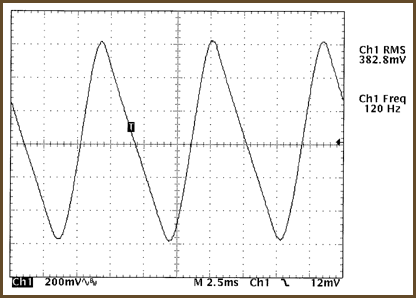
|
As you can see, there is nearly 400 mV of ripple on this power supply, a Creek OBH-1. (The test was done at full load.) The high ripple voltage is a result of this supply’s small physical size: the case only has room inside for a small filtering capacitor.
Problems With Unregulated Power Supplies
The first problem is that there’s a practical limit on how much you can reduce the ripple voltage. Unregulated supplies are used whenever small size and/or low cost are the primary design goals. Therefore, the filter cap ends up being on the small side, so all practical unregulated supplies put out a significant amount of ripple.
The other main problem is that an unregulated power supply simply puts out an analog of the AC input voltage as DC: any variation on the AC side is directly translated into DC variation. Let’s say you’re using the 120 VAC to 20 VDC power supply depicted above, and that there’s a brownout that drops the wall voltage to 108 VAC. Because the transformer puts out 1/6 the input voltage no matter what that is, the power supply will put out 18 V as long as the brownout lasts. The same sort of thing happens if your wall power has hash or voltage spikes on it: the ugliness appears on the power supply’s output, albeit in a reduced form.
These DC artifacts are collectively called noise and ripple, often abbreviated “N+R.”
Part of a Solution: Regulation
Given that the AC wall voltage varies so much, electrical engineers came up with the idea of power supply “regulation.” This means the DC output voltage is mostly independent of the AC input voltage. One regulated power supply I have is rated to put out a stable DC voltage given anywhere from 108-132 VAC, a 22% variation. An unregulated power supply would simply vary its output by 22% given the same supply range.
There are two kinds of regulation: linear and switch-mode.
Linear Regulated Power Supplies
Most linear power supplies are simply an unregulated power supply followed by some kind of linear regulator. The most common linear regulators are monolithic regulators, being a regulator circuit on a single chip. Occasionally you see linear regulators made of discrete circuitry.
A linear regulator is designed to put out a particular voltage given an input voltage within a fairly wide range. For example, the standard 7815 monolithic regulator is designed to put out 15 VDC given anywhere from 17.5 to 30 V as input. The difference between the minimum input voltage and the output voltage is called the dropout voltage. When the input voltage is below the dropout point, the regulator doesn’t regulate the voltage. When the input is above the dropout point, the regulator works. The voltage dropped across the regulator is turned into heat.
Linear power supplies aren’t perfect. Some noise and ripple still gets through the regulator, and regulators will add some noise of their own. Here are some measured numbers of various linear supplies under a constant 0.25 A load:
|
Switch-Mode Regulated Power Supplies
The other kind of regulation is “switch-mode.” These kinds of power supplies are variously called switch-mode power supplies (SMPS), switchers, or switching power supplies.
Let’s say you want 15 VDC and the wall supply voltage has sagged to 100 VAC. If you simply turn the power on and off very rapidly so that it’s only on 15% of the time, you get 15 V on average. That gives a choppy waveform, but it isn’t difficult to smooth that out. If the wall voltage goes up to 120 VAC, the swticher simply limits its “on” time to 12.5% so that the output remains at 15 V. (This is greatly simplified. Real switchers are more complicated.)
The advantages of a switcher are that it’s very efficient, it can be made physically smaller than a linear power supply, it puts out less heat, and it can operate over a much wider range of input voltages than a linear power supply.
The disadvantages of a switcher are that the switching component adds quite a bit of noise to the output power. I’ve seen many different switching frequency signatures. The better switchers have all of their noise up in the megahertz range, so that there’s virtually no noise in the audio band. More commonly the switching frequency is up in the tens of kHz with some sub-harmonics extending into the audio band, plus possibly also some low-frequency ripple. Then there are the really cheap switchers, with a switching frequency right in the middle of the audio band.
Here’s the noise I saw on a Phihong PSA18U-180 switcher under an 0.25 A load:
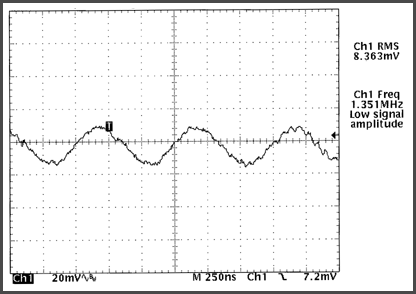
|
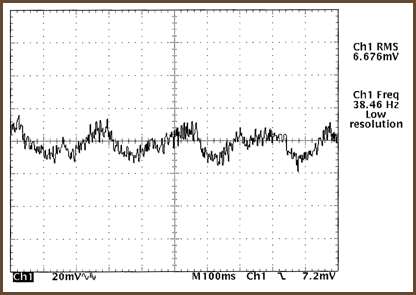
|
The top image is the main switching frequency, at about 1.3 MHz. This is one of the faster swtiching speeds you’ll see. Below it is the low frequency noise. The main ripple you see is about 3 Hz, and the jaggy stuff on on top of that is the 38 Hz noise that the scope measured.
Does Any of This Matter?
After looking at the scary switcher noise graph above, you might immediately swear to only use linear power supplies and NiMH batteries forever more. But it’s premature to make such a decision without first deciding whether that noise actually matters. To do that, you must understand the application.
Consider a simple op-amp based headphone amplifier, like the CMoy pocket amplifier. This circuit has a single op-amp per channel doing the amplification. Noise and ripple (N+R) on the power supply affects an op-amp’s output, so op-amp manufacturers publish Power Supply Rejection Ratio (PSRR) ratings for their chips. Here’s a typical PSRR graph:
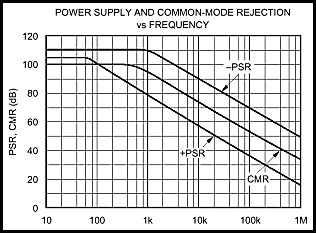
|
|
OPA2132 PSRR graph |
(You can ignore the “common mode rejection” part of the graph. It isn’t pertinent to this discussion.)
As you can see, PSRR is dependent on frequency, and in the case of the OPA2132 the V+ and V- pins reject noise differently. Consider the +PSR curve on the graph: at low frequencies, it’s about 104 dB. So, the 6.7 mV low-frequency noise we measured above is reduced by a factor of about 158,000 (104 dB) to 0.04 µV at the output of the op-amp. If your amp’s gain was 10 and the full-scale signal to the headphones was 0.5 V, this noise would be -121 dB below full scale. Completely negligible.
As for the HF noise shown above, that’s so far above the audio band that it, too is negligible.
Now, consider the Creek OBH-1 unregulated supply above. Would this be a good supply for a CMoy amp? Sadly, no. Ripple rejection is about 100 dB at 120 Hz with the OPA2132, and the noise level was 383 mV. If our full-scale signal is 0.5 V an the gain is 10, the noise appears at the op-amp’s output as -82 dB. That’s audible. (In case you’re wondering, this supply works okay with the Creek OBH-11 headphone amp because that amp has a linear regulator inside.)
Conclusion
Does power quality matter? Certainly. Should you avoid unregulated power supplies for op-amp audio? Yes, unless you add external regulation. Are batteries and linear power supplies the only suitable power sources, then? Well, no. Modern switching power supplies have ultrasonic switching frequencies, and a good switcher will have low ripple as well. True, this is not technically ideal, but in practice this noise doesn’t usually affect sound quality for low-gain amplifiers.
As for ripple, you can sometimes get away with constant low frequency ripple if your op-amp has a high PSRR rating at the ripple frequency. But in my opinion, power supply ripple is worth spending time and money to avoid. Induced ripple due to current demands is also worth getting rid of, but it’s not nearly as big a concern as noise and constant ripple.
